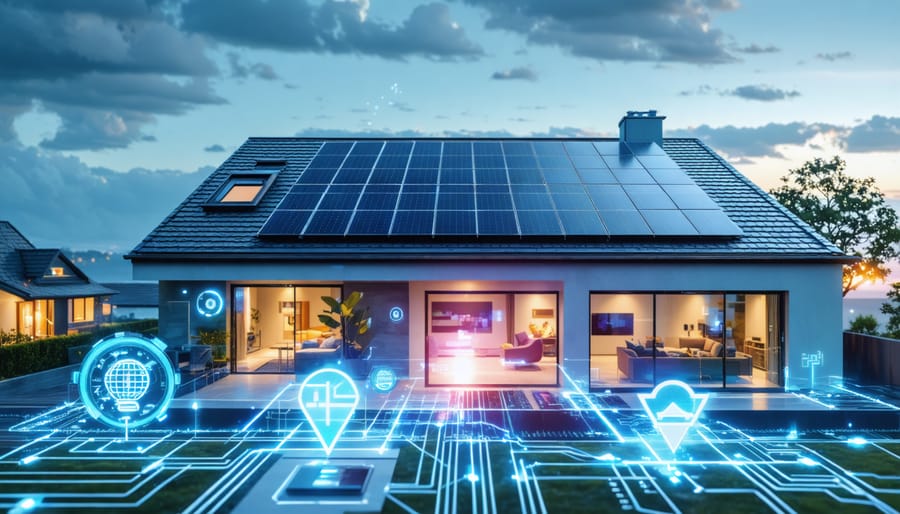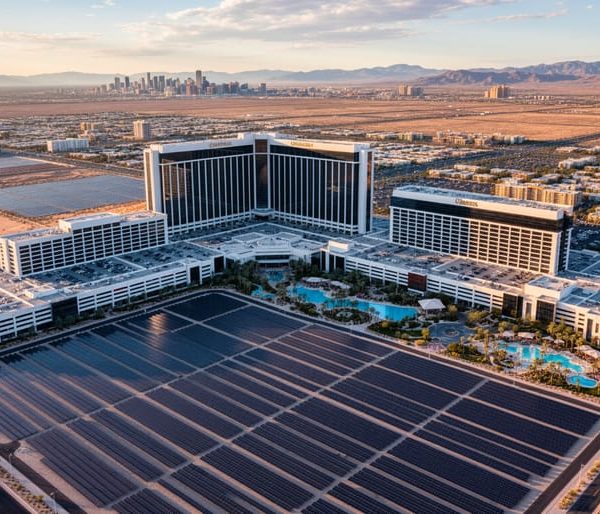Solar Panel Breakthroughs Revolutionizing Home Lighting Systems
Solar panel technology is revolutionizing how we power our homes, with innovations emerging faster than ever before. Recent market data shows a 40% increase in residential solar installations over the past year, driven by groundbreaking advances in panel efficiency and smart home integration. Modern solar panels now convert up to 23% of sunlight into electricity – a dramatic improvement from the 15% efficiency standard just five years ago.
Today’s solar trends reflect a perfect storm of technological innovation, decreasing costs, and growing environmental awareness. Bifacial panels that capture reflected light, artificial intelligence-powered monitoring systems, and ultra-thin perovskite cells are reshaping what’s possible in residential solar power. These advancements aren’t just technical achievements; they’re making solar energy more accessible and practical for everyday homeowners.
For property owners considering the switch to solar, understanding these trends isn’t just about staying current – it’s about making informed decisions that will impact their energy independence and environmental footprint for decades to come.
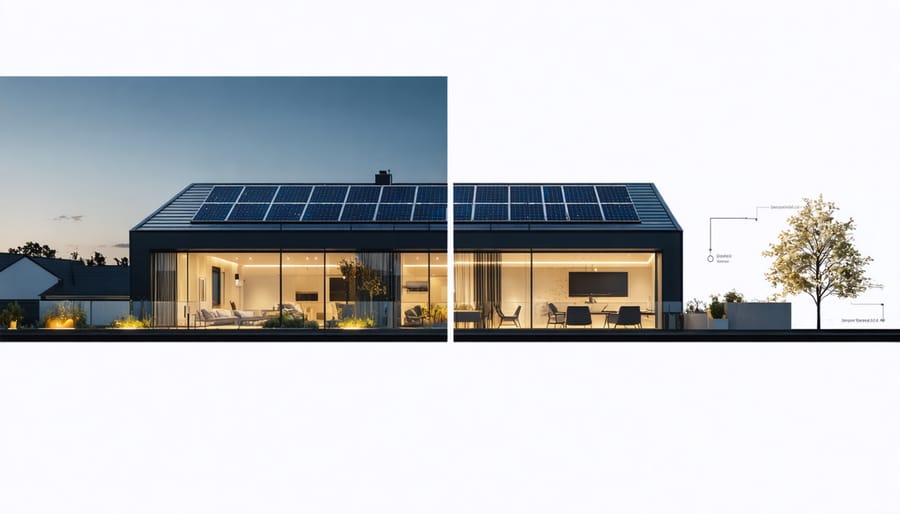
Smart Solar Panel Integration in Modern Lighting
Adaptive Power Management Systems
Modern solar panel systems are getting smarter thanks to adaptive power management technology. These intelligent systems continuously monitor energy production, storage, and consumption patterns to optimize power distribution throughout your home or building. Think of them as energy traffic controllers, directing power where and when it’s needed most.
Using artificial intelligence and machine learning, these systems can predict your energy needs based on historical usage data and weather forecasts. During peak sunlight hours, they might direct excess power to charge batteries or run energy-intensive appliances. When clouds roll in, they automatically adjust to conserve stored energy for essential needs.
What makes these systems truly remarkable is their ability to learn and adapt. They can recognize patterns in your energy usage and automatically adjust settings to maximize efficiency. For example, if you typically run your dishwasher in the evening, the system will ensure enough solar energy is stored during the day to power it.
Many homeowners report energy savings of 20-30% after installing adaptive power management systems, making them a smart investment for both the environment and your wallet.
Wireless Connectivity Features
Modern solar panels are becoming increasingly connected, offering homeowners unprecedented control over their energy systems. Through smart solar lighting integration, users can now monitor and adjust their solar panel performance from their smartphones or tablets.
These wireless features allow real-time tracking of energy production, consumption patterns, and system health. Homeowners can receive instant notifications about maintenance needs or performance issues, ensuring their solar installation operates at peak efficiency. The user-friendly apps make it simple to schedule lighting routines, adjust brightness levels, and even coordinate with other smart home devices.
Many systems now incorporate weather-responsive automation, automatically adjusting energy storage and usage based on weather forecasts. For example, when cloudy days are predicted, the system can automatically conserve stored energy to maintain consistent power supply.
The connectivity also enables remote troubleshooting, reducing maintenance costs and system downtime. Some advanced systems even learn from your usage patterns, automatically optimizing energy distribution to match your lifestyle while maximizing cost savings.
High-Efficiency Panel Designs
Bifacial Solar Panels
Bifacial solar panels represent one of the most exciting innovations in solar technology, offering a smart solution for maximizing energy production in the same footprint as traditional panels. These innovative panels capture sunlight from both sides, allowing them to harness direct sunlight from above and reflected light from below.
The unique design enables these panels to generate up to 30% more energy compared to conventional single-sided panels, making them particularly effective in areas with highly reflective surfaces like white roofs, light-colored ground cover, or snow. Many homeowners are discovering that installing bifacial panels over light-colored gravel or white membrane roofing can significantly boost their energy production.
Installation height plays a crucial role in bifacial panel performance. Mounting these panels with adequate clearance from the roof or ground allows more reflected light to reach the rear surface. Commercial properties with flat roofs or ground-mounted systems often see the best results, though residential installations can also benefit significantly when properly positioned.
While bifacial panels typically cost about 5-10% more than traditional panels, the increased energy production often leads to a faster return on investment, especially in locations with optimal conditions for reflected light capture.
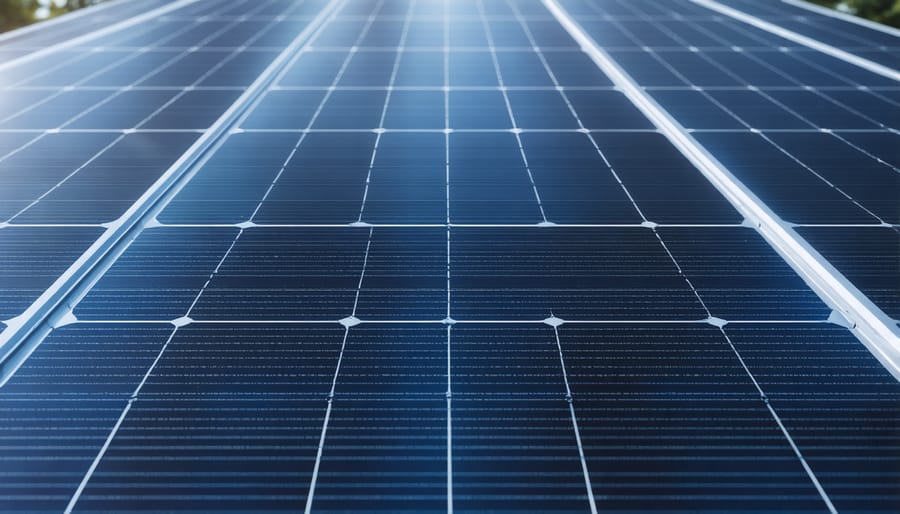
Compact Form Factors
Today’s solar lighting solutions are embracing innovative compact designs that maximize space efficiency without compromising performance. Manufacturers are creating sleek, low-profile panels that seamlessly integrate into existing architectural elements, making them perfect for urban homes and tight spaces.
These space-saving designs include thin-film solar panels that can be applied directly to windows and skylights, dual-purpose solar tiles that replace traditional roofing materials, and flexible panels that conform to curved surfaces. Some popular options feature modular systems that can be customized to fit specific areas, whether it’s a narrow balcony railing or a small garden path.
For homeowners with limited roof space, vertical solar panels are gaining popularity. These panels can be mounted on walls or fences, turning previously unused surfaces into power-generating assets. Mini solar panels for individual light fixtures are another space-efficient solution, eliminating the need for extensive wiring or large panel arrays.
Many compact designs now incorporate built-in battery storage, ensuring reliable lighting even in small installations. These all-in-one units are particularly useful for apartments and townhouses where space is at a premium. The latest models feature weather-resistant materials and streamlined mounting systems, making installation straightforward while maintaining a clean, modern aesthetic.
Cost-Effectiveness and Energy Savings
Return on Investment Calculations
Understanding the financial benefits of solar panels starts with calculating energy savings with solar lighting. A typical home solar panel system costs between $15,000 to $25,000 after federal tax incentives, but the long-term savings make it a smart investment. Most homeowners see their investment returned within 5-8 years, depending on local electricity rates and sunlight exposure.
To calculate your potential savings, consider that the average household saves $1,500 annually on electricity bills after installing solar panels. Additional incentives like net metering, where excess energy is sold back to the grid, can further reduce payback periods. Solar panels typically last 25-30 years, providing two decades of essentially free electricity after the initial investment is recovered.
Modern solar systems also increase property values by an average of 4%, making them an attractive investment even if you plan to sell your home. When factoring in rising energy costs, the return on investment becomes even more compelling, with some homeowners reporting total savings exceeding $30,000 over their system’s lifetime.
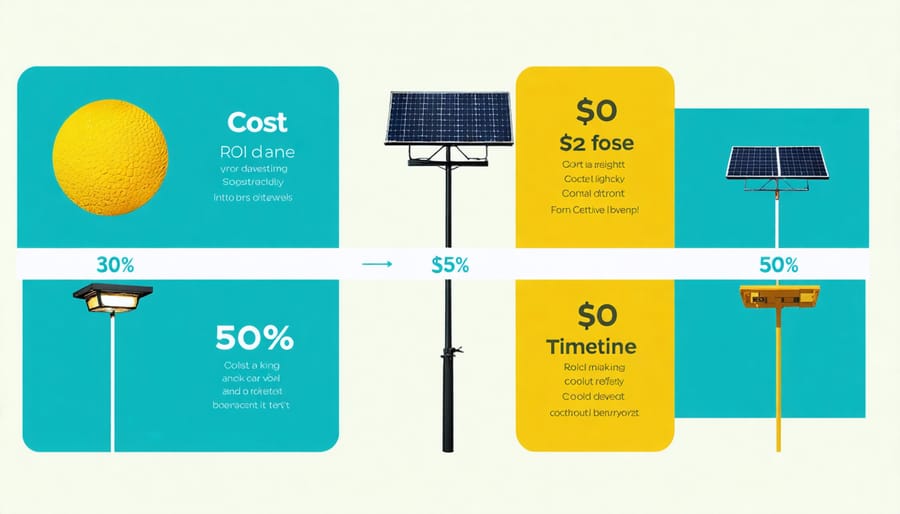
Energy Storage Solutions
Energy storage has become a game-changer in the solar panel industry, with advanced battery systems making 24/7 solar power a reality. The latest lithium-ion batteries offer improved capacity and longer lifespans, typically lasting 10-15 years with proper maintenance. These modern storage solutions enable homeowners to store excess energy generated during sunny days for use during nighttime or cloudy weather.
Smart power management systems are revolutionizing how we use stored solar energy. These systems automatically prioritize stored power during peak utility rates and switch to grid power when rates are lower, maximizing cost savings. Many newer systems also include user-friendly apps that let you monitor energy usage and storage levels right from your smartphone.
For homeowners concerned about space, compact wall-mounted batteries are now available that take up minimal room while providing substantial storage capacity. Some popular options even allow you to start small and add more storage capacity as your needs grow.
Emergency backup power is another key benefit, with modern storage systems automatically kicking in during power outages, keeping essential appliances running without interruption.
Installation and Maintenance Considerations
Installing solar panels for lighting systems has become increasingly straightforward, but proper planning and maintenance are essential for optimal performance. Before installation, conduct a thorough site assessment to determine the best panel placement for maximum sun exposure. South-facing installations typically receive the most sunlight in the Northern Hemisphere, with a tilt angle matching your latitude for optimal year-round performance.
Professional installation is recommended for roof-mounted systems, though many ground-level lighting solutions come with DIY-friendly mounting hardware. When installing, ensure panels are securely mounted and weatherproofed, with proper drainage to prevent water accumulation. Cable management is crucial – use UV-resistant conduits to protect wiring from environmental damage.
For maintenance, develop a regular cleaning schedule to remove dust, leaves, and bird droppings. A simple solution of water and mild soap, applied with a soft brush or sponge, is usually sufficient. Avoid abrasive materials that might scratch the panel surface. In snowy regions, invest in a long-handled brush for safe snow removal.
Monitor your system’s performance through the accompanying app or control panel. Most modern systems alert you to potential issues, but regular visual inspections can catch problems early. Check for loose connections, damaged wiring, or signs of water ingress every six months.
Battery maintenance is equally important for storage-based systems. Most modern lithium batteries require minimal maintenance, but they should be kept at optimal temperature ranges and charge levels. Replace batteries according to manufacturer recommendations, typically every 5-10 years, to maintain system efficiency.
Remember to keep vegetation trimmed around ground-mounted panels and ensure roof-mounted systems have adequate ventilation to prevent overheating. With proper installation and maintenance, your solar lighting system can provide reliable illumination for decades.
As we look ahead, the future of solar panel technology appears brighter than ever. The industry continues to evolve with remarkable advances in efficiency, affordability, and smart integration. Homeowners and businesses are increasingly embracing solar solutions, driven by improved aesthetics, better energy storage options, and significant cost savings.
The trend toward bifacial panels, which capture light on both sides, is gaining momentum, while perovskite solar cells promise even higher efficiency rates at lower costs. Smart solar systems are becoming the norm, offering enhanced monitoring and optimization capabilities that make solar power more accessible and user-friendly than ever before.
Looking forward, we can expect to see more innovative designs, including solar tiles that blend seamlessly with traditional roofing materials, and advanced energy management systems that maximize power generation. With government incentives, decreasing installation costs, and growing environmental awareness, solar adoption is set to accelerate dramatically in the coming years.
For property owners considering solar installation, there’s never been a better time to make the switch to clean, renewable energy. The technology is proven, the benefits are clear, and the future is decidedly solar-powered.

